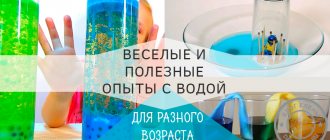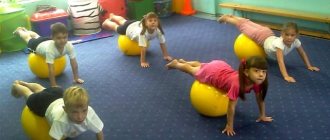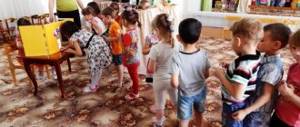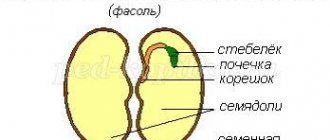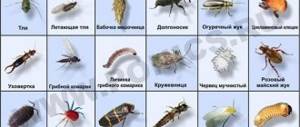Experiment 2. Purpose: to determine whether there is water in the soil.
Procedure of the experiment: put a piece of soil on a plate and heat it. Place glass on top. Droplets of moisture will appear on the glass.
Conclusion: there is moisture in the soil.
Experiment 3. Purpose: to determine what the soil consists of.
Progress of the experiment: we will continue to heat the soil. An unpleasant odor appeared. This burns humus, plant and animal remains.
Conclusion: the soil consists of humus.
Experiment 4. Goal: to determine what else the soil consists of.
Procedure of the experiment: throw the calcined soil into a glass of water and stir. It settles in the form of sand and clay.
Conclusion: in addition to humus, the soil contains sand and clay.
Experiment 5. Goal: to determine what else the soil consists of.
Progress of the experiment: let's filter the water in which the soil has been sitting for some time. Let's heat the water and evaporate it. A white coating will remain in place of the water; these are mineral salts.
Conclusion: the soil contains mineral salts that dissolve in water.
The world around us 3rd grade
What is soil
The top fertile layer of the earth is soil . The main property of soil is fertility .
Practical work “Soil composition” Perform experiments. Record the results in the table.
Experiment 1. Throw a lump of dry soil into the water. We will see air bubbles coming out of the soil. This means there is air in the soil. Experiment 2. Heat some fresh soil over a fire. Hold the cold glass over the soil. Soon the glass will become damp. This experiment shows that there is water in the soil. Experiment 3. We will continue to heat the soil. Soon we will see smoke and smell an unpleasant smell. This burns humus soil, which was formed from the remains of plants and animals. Humus gives the soil a dark color. Experiment 4. Pour the calcined soil, in which all the humus has already burned (it is gray), into a glass of water and stir. After some time, sand will settle to the bottom of the glass, and clay will settle on top of the sand. Experiment 5. Let's filter the water in which the soil has been sitting for a long time. Place a few drops on the glass. Let's keep him on fire. The water will quickly evaporate, leaving a white coating on the glass. These are mineral salts. This means that the soil contains mineral salts that dissolve in water.
| Experience no. | The soil contains... |
| 1 | air |
| 2 | water |
| 3 | humus |
| 4 | sand, clay |
| 5 | mineral salts |
So, the composition of the soil includes air, water, humus, sand, clay, and mineral salts. Plant roots breathe air contained in the soil. They absorb water from the soil. Plants absorb dissolved mineral salts along with water. Salts are nutrients without which plants cannot live .
List what plants get from the soil. Plants receive from the soil: air, water, mineral salts.
Solve the crossword puzzle “Soil:
1. The top layer of soil on which plants grow. Answer: soil 2. A substance that is part of the soil, thanks to which plants grow better. Answer: humus 3. The main property of soil. Answer: fertility 4. One of the components of soil. Answer: sand
There is little salt in the soil. Plants could quickly use them up, but this does not happen. The supply of salts in the soil is constantly replenished thanks to humus. Humus, under the influence of bacteria that live in the soil, slowly, gradually turns into salts. The more humus in the soil, the more fertile it is. Animals living in the soil make passages in it, where water and air easily penetrate, mix the soil, and crush plant remains. This is how animals increase soil fertility.
What animals live in the soil? Answer: Mole cricket, beetle larva, cricket, mole, centipede, toad, wood mouse, earthworm.
check yourself
What is soil?
Soil is the top fertile layer of the earth.
What is the composition of the soil?
The soil consists of humus, sand, clay and mineral salts.
How to prove that the soil contains air, water, humus, sand and clay, and salts?
You can prove that there is air in the soil by throwing the soil into water.
You can prove that there is water in the soil by heating it.
You can prove that there is humus in the soil by calcining it.
You can prove that there is sand and clay in the soil by stirring calcined soil in water.
You can prove that there are salts in the soil by filtering the water and evaporating it.
What living things live in the soil? How do they affect her fertility?
Many animals live in the soil. These are mammals - moles and mice, insects - beetle larvae, mole crickets, centipedes, worms.
All these animals improve the fertility of the soil, loosen it and process organic remains.
The soil also contains bacteria that convert organic matter into mineral salts, which are necessary for plant growth. Bacteria also improve soil fertility.
The soil
Hi guys! I am very glad to meet you again. Look, I have something in my bag today. To find out what it is, guess my riddle.
The topmost layer of earth,
Grass and trees grow in it,
Possesses fertility
What does everyone call her?
Did you guess it? Of course it's the soil
.
So, my young friends, today I will tell you about how I studied soil
and what I learned about it.
I read in your books that the soil
- This is
the top fertile layer of the earth.
What does this top layer
?
— I thought, “we definitely need to figure it out.” I was lucky, I met with one scientist who studied the structure of the earth's crust
.
Look, it's him. Now he is working, he has gone down deep into the pit and is diligently exploring something. This scientist showed me what soil looks like
.
See that dark top layer
.
This is the soil
.
It contains plant roots and some animals live.
This kind scientist also told me how soil was formed
.
It turns out that previously the soil did not cover the Earth with a fertile layer
.
On the surface of the Earth there were only stones and rocks. But under the influence of winds, rains, frost and heat,
the rocks gradually cracked and collapsed.
The cracks became wider and wider, and the stones splintered. a loose layer
gradually formed into which water and air could penetrate.
The most unpretentious plants
, the seeds of which were carried by the wind, settled on it, took root, and when rotting, formed a thin layer
of humus
.
The seeds
fell into this layer , they grew, and when they died, they also
increased the layer of chernozem
.
So the soil gradually formed
. But this process was not quick. It took thousands of years.
I also learned that the most important property of your soil is
- this is
fertility
, i.e.
the ability to ensure the growth and development of plants
.
Why is the soil fertile?
?
- I thought. Probably because it contains everything necessary for plant life
.
What is necessary for plant life? Air, water, humus, mineral salts.
To find out if all this is in the soil
, I conducted several experiments.
Experiment 1. I took a lump of dry soil
and threw it into a glass of water.
Air bubbles began to emerge from the soil. This means there is air in the soil
.
Experiment 2. I again took some soil and heated it on the fire.
.
the cold glass
over the soil .
Very soon the glass became wet
.
This allowed me to conclude that water
in the soil .
Experiment 3. I removed the glass and continued heating the soil
.
After a while I saw smoke appearing
and also smelled
an unpleasant odor
.
This burned humus soil
, which was formed from the remains of plants and animals.
This means, I concluded, the soil contains humus
.
It is humus that gives the soil its dark color.
Experiment 4. Calcined soil
, in which all the humus had already burned, I poured it into a glass of water and stirred, after a while
sand settled to the bottom of the glass, and clay settled on top of the sand
.
This indicated that the soil contained sand and clay
.
Experiment 5. I put the soil in a glass of water
.
I mixed everything thoroughly and let it sit. Then I took a few drops of this water and placed it on the glass. He began to heat it, holding it over the fire
.
The water quickly evaporated
.
a thin white coating
remained on the glass .
These are mineral salts
.
This experiment showed that the soil contains mineral salts
that can dissolve in water.
The experiments I carried out showed that:
Now that I know the composition of the soil
, I can tell you exactly why she is
fertile
.
Plant roots breathe air
contained
in the soil
.
They also absorb water from the soil
minerals
dissolved in it enter the plant .
Minerals
(or
mineral salts
) are
nutrients for plants without which they cannot live.
All plants on your planet consume minerals .
This means that the reserves of mineral substances in the soil should be quickly used up
.
But this doesn't happen. This supply is constantly replenished thanks to humus
.
Humus,
under the influence
of bacteria
that live in
the soil
, slowly, gradually
turns into salts
.
The more humus in the soil, the more fertile it is
.
Soil fertility
The animals living in it also increase.
For example, earthworms
.
They dig tunnels in the soil, deeply mixing the soil
.
Earthworms
feed on
rotting plants
and drag them from the surface of the earth into their burrows.
This increases the amount of humus in the soil
.
Air
easily penetrates into the soil along the worm tunnels and
rainwater
.
Worms, like other animals, when dying , enrich the soil with humus.
And recently, in a conversation with that scientist I knew, I learned that there is a whole
science about soils
.
It's called soil science
.
And this science was created by the Russian scientist Vasily Vasilyevich Dokuchaev
.
He called the soil the nurse of man and believed that it was more valuable to people than oil and gold.
Homework assignments
Write down the main property of soil in your dictionary.
The main property of soil is Fertility. It allows plants to grow.
At home, look at the soil in flower pots. Find dead remains of plants in it. We loosened the soil so that air could flow better to the roots. Don't forget to water the plants.
I have several flower pots at home. Plants drop flower petals, dried leaves, and twigs into the soil. All this becomes dead remains. In order for air to flow better to the roots of the soil in pots, you need to loosen it often. And, of course, the plants need to be watered regularly.
Based on the diagram on p. 66 make a model and use it to tell what plants get from the soil.
To make a diagram, we will take a plant from a herbarium, which has an aerial part with leaves and a root system.
Glue the plant onto a sheet of paper. Let us denote the interface between soil and air. Below the interface, in the soil, let us schematically depict the oxygen that flows to the roots of the plant; water flowing to the roots; humus turning into salts; and dissolution of salts in water.
In the book “The Giant in the Glade,” read the story “Respect the Life of the Earthworm.” What new things did you learn about him from the story? How do you feel about earthworms?
From the story, I learned that worms crawl to the surface after rain not to swim, but because they can’t breathe in their holes filled with water.
I learned that at night the worm sticks its head out and probes the ground in search of food. It eats rotting leaves and blades of grass.
Earthworms dig a huge number of holes in which air accumulates. Plants need air to breathe. Therefore, earthworms are very useful; they improve soil fertility.
I have a good attitude towards earthworms and would never hurt them. They live their own lives and are needed by nature, and even if they are not beautiful, they are very useful.
Educational and research project for children of the senior group “Soil – Living Earth”
Educational and research project for children of the senior group “Soil – Living Earth”
Relevance of the project.
The world's soil resources are limited. As a result of improper exploitation of soil cover, soil destruction occurs, loss of fertility and alienation of land from active agricultural use. In Russia there are a large number of areas with catastrophically deformed nature, in which soil degradation occurs. And soil, like any other habitat, is an important condition for the existence of life. Living organisms in the soil, like the soil itself, need care and protection. All this emphasizes the need for careful and rational use of soil resources from depletion, destruction and pollution.
The project “Soil - Living Earth” proposes a solution to the problem of preparing children to understand environmental problems through the organization of experimental activities in kindergarten. The practical use of this development will allow preschoolers to form real ideas about the various aspects of the object being studied, about its relationships with other objects and with the environment.
Author:
Vorozhtsova Natalya Sergeevna – teacher of the senior group
Project type
educational, research.
Project type
group
Implementation deadlines
: mid-term (June - August)
Project participants:
children of senior preschool age, parents of pupils, teachers.
Objective of the project
Give an idea of the soil and its significance;
Practically prove in which soil it is better to grow crops.
Develop the ability to analyze a problem (identify and compare wet and dry soil, soil properties);
Develop the ability to justify the conclusions drawn and apply them in life.
Tasks:
Formation of children's ideas about soil as the top fertile layer of the earth, its composition and significance.
Acquaintance with the “underground kingdom”: the inhabitants of the soil, their characteristics, their role in the formation of the soil.
Formation of the concept of the need to take care of the soil and its inhabitants, the importance of soil animals in nature.
Teach children to care for plants in the experimental bed
Learn to observe changes in the development and growth of plants.
Teach children to compare soils for better growing of cultivated plants.
Learn to make simple conclusions through experimental research activities;
Speech development and vocabulary enrichment
Developing skills in conducting laboratory work
Expected Result:
Development of children's cognitive activity in the process of experimenting with soil;
Soil and its composition. 3rd grade. The world.
Teacher's comments
Greetings, Soil Fertility
Do you know what the main property of soil is? The main property of soil is its fertility. Soil is the top fertile layer of the earth. That is, it is a layer containing substances that are necessary for the growth and development of plants, without which there can be no fruits. To find out what plants get from the soil, let's study its composition by doing experiments with the soil.
Soil composition
The soil is dark in color. If we look at a soil sample through a magnifying glass, we will see the remains of half-rotten roots and leaves of plants, parts of the bodies of worms, insects and other small animals (Fig. 1).
Rice. 1. Soil (Source)
If you put a piece of dry soil into a glass of water, how can you explain the appearance of air bubbles in the water? This experiment shows that the soil contains air.
After putting the soil in a glass of water, you need to stir it and let it settle. Using a pipette, take a few drops of this water and place it on a glass slide. Now you need to heat the glass over the candle fire. After the water evaporated, a thin white coating remained on the glass; these are mineral salts. This experiment showed that the soil contains mineral salts that can dissolve in water.
You can put the soil in the lid, then heat it over a candle flame. The glass is held above the soil. The glass first becomes wet, and then droplets of water appear on it. This is water that is contained in the soil; when heated, it evaporates. Water vapor rises up, meets cold glass on its way, cools and turns into tiny droplets of water (Fig. 2).
Rice. 2. Experiments on soil (Source)
This experiment shows that there is water in the soil. If you continue to heat the soil, smoke and an unpleasant odor will soon appear. This burns part of the soil, which consists of decaying remains of plants and small animals. This is an integral part of the soil - humus. If you heat the soil on fire for a very long time, the humus will completely burn and the soil will turn gray. This proves that humus gives the soil a dark color.
If you put a little soil in a glass of water, stir it and let it sit, you will see a layer of sand settle to the bottom, a layer of clay on top of it, and a dark-colored layer on top - this is humus. This proves that the soil contains sand and clay (Fig. 3).
Rice. 3. Experiments on soil (Source)
What are the results of the experiments and observations carried out? We learned that soil consists of air, water, mineral salts, humus, sand and clay.
Soil wildlife
There is always living nature in the soil: plant roots, bacteria, earthworms, ants, dung beetles and many others. They gnaw plant roots, crush something, drag it, collect it.
What do plants get from the soil? Firstly, air, the roots of plants breathe the air that is in the soil. Secondly, water. Plants absorb nutrients along with water. The remains of dead plants and animals are processed by bacteria and insects that are in the soil. Thus, the soil is constantly replenished with humus and mineral salts. This is a real storehouse of nutrients for plants. In addition, animals living in the soil loosen it, and air and water penetrate better into the soil.
The earth is the nurse
When they say that the earth is a nurse, they mean the soil. Plants take water and nutrients dissolved in it from the soil. Many animals eat plants. Insects eat plant roots, stems, leaves (Fig. 4), granivorous birds feast on fruits. Plant food is eaten by cows, horses, and moose.
Rice. 4. May beetle (Source)
Herbivorous animals become prey for predators. Consequently, predatory animals depend on soil fertility.
Man grows grains, vegetables, legumes, fruits and ornamental plants on the earth. Fertile soil provides people with clothing made from cotton and flax, domestic animals with food, and they provide people with milk, meat, eggs, honey, wool and many other products. Soil is the most important wealth of the country, so farmers take care of increasing its fertility and protecting it.
Taking care of the soil
How do people take care of the soil? In order for the soil to better allow air to pass through and retain water, it is dug up and loosened annually. When digging in autumn after harvesting, the clods of earth do not break up; in winter, snow is retained between them, so in spring the soil is better saturated with water. The soil is loosened in the spring, just before sowing (Fig. 5). In loose soil, seeds germinate better, sprouts emerge faster, and the root system develops well.
Rice. 5. Loosening the soil (Source)
There are very few dissolved salts in the soil, so it is necessary to replenish salt reserves annually. Factories produce fertilizers that contain all the mineral salts necessary for plant growth. But there are also very good natural fertilizers, these are peat and manure. They are applied to the soil in the fall. The richer the soil is in humus, the more fertile it is. Due to the dark color, the soil warms up better under the sun's rays.
What harms the soil? Damage to the soil is caused by ravines (Fig. 6), strong winds, heavy rains, wheels of passing cars, and household garbage. But people have learned to deal with ravines, for example, their slopes are plowed not along, but across.
Rice. 6. Ravines (Source)
Sprouts retain water, and it does not flow down the slope and does not erode the soil. Also, to stop the growth of ravines, shrubs and trees are planted on the tops and slopes of the ravine. In places where strong winds are frequent, people plant shelterbelts and sow grass.
Summarizing
Today in the lesson you gained knowledge about the composition of soil. You also learned the importance of soil for human life.
SOURCES
https://interneturok.ru/ru/school/okruj-mir/3-klass/vzaimosvyaz-nezhivoy-i-zhivoy-prirody/pochva-i-eyo-sostav
https://www.youtube.com/watch?v=nTMCgoqNQ8A
https://www.youtube.com/watch?v=meUUt7CtwIk - screensaver
